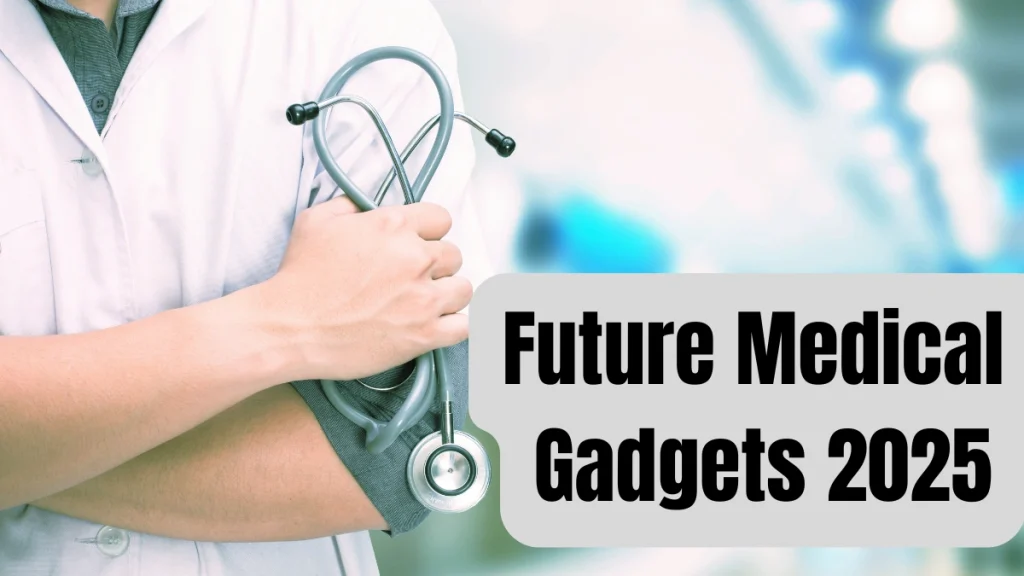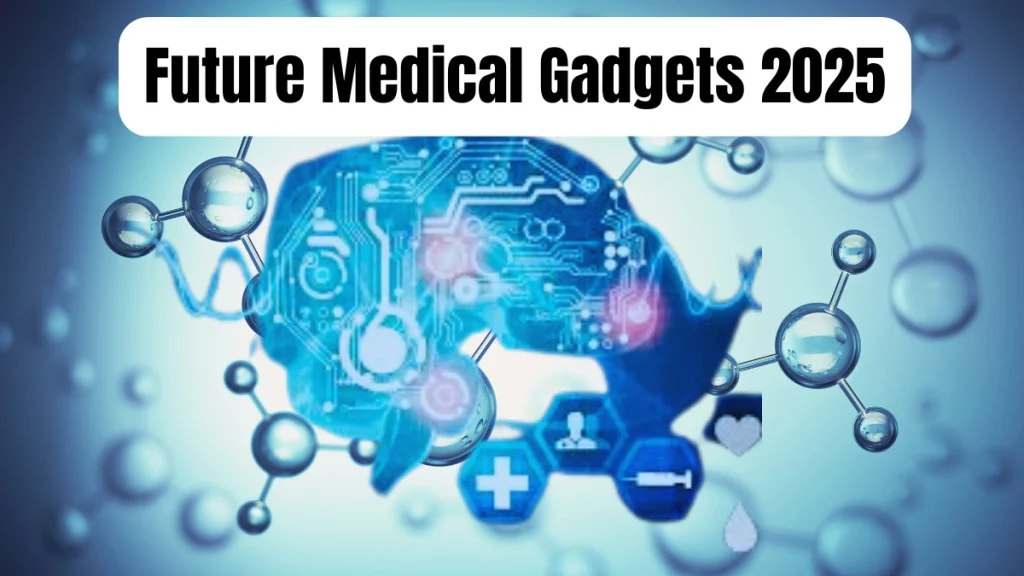A technological revolution in the healthcare industry is imminent. Future Medical Gadgets 2025 and medical diagnosis are about to undergo a transformation thanks to upcoming medical equipment and healthcare technologies. The landscape of cutting-edge Medical Gadgets will change significantly by 2025. This will change modern medicine by ushering in a new era of tailored, data-driven, and AI-powered solutions.
Futuristic medical devices in a sleek, high-tech environment, showcasing advanced wearable health monitors, robotic surgical instruments, and AI-assisted diagnostic tools, all designed with smooth lines and illuminated interfaces, displaying a vibrant color palette with blue and silver accents, emphasizing innovation and cutting-edge technology.
Vital indicators will be continuously monitored via wearable technology advancements. AI-driven diagnostic technologies will detect health problems with unparalleled precision. Better patient outcomes, a higher standard of living, and a more effective healthcare system are all anticipated with the advancement of medical technology. We will examine the major developments and trends that will influence the market for Medical Gadgets in the years to come.
Table of Contents
ToggleThe Future of Medical Gadgets Technology
Technological breakthroughs are driving a substantial transition in the healthcare sector. By 2025, wearable technology and AI-powered diagnostic instruments are expected to completely transform healthcare. These Improvements in patient monitoring, early disease detection, and more individualized treatment options are all anticipated outcomes of these improvements.
Advancements in Wearable Devices
Wearable medical technology has advanced greatly, and it is anticipated that its capabilities will continue to expand. These gadgets may now track a number of health indicators, such as blood pressure, heart rate, activity levels, and sleep habits. They give patients the ability to actively manage their health by integrating with cloud platforms and cellphones.
AI-Powered Diagnostic Tools
The healthcare sector is being profoundly impacted by artificial intelligence (AI), particularly in the area of diagnostic tools. AI in healthcare makes it possible to develop sophisticated algorithms that examine enormous Medical Gadgets databases, spot trends, and provide information for early illness detection and individualized treatment regimens. The way medical professionals identify and treat patients is about to change as a result of these smart medical technology.
The future of medical technology is about to be redefined by the combination of wearable technology and AI diagnostics. A new era of proactive, individualized, and accurate healthcare is promised by this convergence. Patients should anticipate better monitoring, quicker interventions, and more individualized therapy options as these technologies develop. In the end, this will result in improved health and a greater standard of living.
Nanotechnology and Targeted Drug Delivery

Healthcare is changing as a result of nanotechnology, particularly in the area of targeted medicine delivery. For more accurate drug delivery, it makes use of Nanoscale tools and materials. Better patient outcomes and fewer adverse effects result from this.
One significant advantage of nanotechnology is its capacity to target particular cells or tissues. It brings medications straight to the places that are impacted. This exact targeting, which is crucial for customized medicine, increases therapy efficacy while preserving healthy cells.
Liposomes and polymeric nanoparticles are examples of nanoscale drug carriers that can encapsulate and deliver therapeutic medicines to the appropriate site inside the body.
It is possible to design nanomaterials to react to particular stimuli, like pH shifts or enzyme activity, so that the medicine is released only when it reaches the intended location.
The ability of nanorobots, or “nanobots,” to travel the body, recognize damaged cells, and precisely administer therapies is being investigated..
A future where tailored medicine is a reality is promised by the incorporation of nanotechnology into healthcare. Drug efficacy is maximized and side effects are minimized when therapies are customized to each patient’s needs and characteristics. Better patient outcomes and a more effective healthcare system result from this.
A futuristic laboratory scene showcasing advanced nanotechnology in healthcare, featuring microscopic robots administering targeted drug delivery within human cells, vibrant colors highlighting the intricate details of nanoparticles interacting with tissues and blood vessels, a visually striking representation of technology merging with biology.
We can anticipate ground-breaking discoveries as tailored drug delivery and healthcare nanotechnology research progresses. The possibilities of this It’s exciting to see how technology can transform medical care. A healthy future is what it promises..
Future Medical Gadgets 2025
The medical field is about to undergo a major transformation as 2025 draws closer. The rapid advancement of technology is to blame for this. The new medical gadgets technologies that will revolutionize healthcare and illness treatment are at the center of this shift.
Predictive Analytics and Personalized Medicine
One of the main highlights is the combination of personalized medicine and predictive analytics. Healthcare professionals will be able to anticipate and avoid health problems with the use of advanced data analysis. More proactive and customized therapies will result from this.
Doctors will be able to design treatment programs that are tailored to the individual requirements and genetic composition of each patient thanks to personalized medicine. Healthcare will be revolutionized by this strategy.
Early disease identification will also be made possible by predictive analytics. People will be able to keep healthy and take preventative measures thanks to this. AI diagnostics and wearable technology will provide patients with real-time health information. This gives people the ability to make knowledgeable healthcare decisions.

Advancements in predictive analytics will revolutionize personalized medicine
Early disease detection through wearable devices and AI-powered diagnostics
Customized treatment plans tailored to individual patient needs and genetic profiles
By 2025, medical gadgets will be at the forefront of this revolutionary change.
They will enable people to take a more active role in their own health management. Medical professionals are prepared to provide more efficient and individualized care by utilizing customized medicine and predictive analytics. Both patient outcomes and quality of life will be enhanced by this.
Telemedicine and Remote Patient Monitoring
Advances in telemedicine and remote patient monitoring are causing a major upheaval in the healthcare industry. Due in large part to their ability to transcend regional boundaries, these technologies have the potential to revolutionize the delivery of healthcare. Access to high-quality medical care has always been hampered by these obstacles.
Overcoming Geographic Barriers
Patients and healthcare providers are becoming closer thanks to telemedicine, which is the remote provision of medical services through digital communication. It makes use of wearable technology, smartphone apps, and video conferencing. This eliminates the need for lengthy travel to obtain prompt, individualized medical care for people living in isolated or underdeveloped locations.
Technologies for remote patient monitoring (RPM) are also quite important. They give medical gadgets personnel the ability to monitor and control patient health from a distance. Healthcare teams receive real-time data from devices such as glucose sensors, blood pressure monitors, and digital scales. This improves patient outcomes and lessens the strain on the healthcare system by enabling preemptive interventions and individualized care regimens.
RPM and telemedicine are working together to make the healthcare system more equal and accessible. Quality medical care is no longer hampered by location.
care. As these technologies evolve and gain wider adoption, the future of healthcare looks more inclusive, efficient, and focused on the patient.
A futuristic telemedicine setup in a sleek, modern home environment, featuring advanced holographic displays showing patient data, wearable health monitoring devices on a bedside table, a virtual consultation screen with a 3D doctor avatar, and soft ambient lighting creating a serene atmosphere.
Robotic Surgery and Prosthetics
Enhancing Precision and Mobility
Prosthetics and robotic surgery are at the forefront of medical technology’s promising future. Advanced robotic surgical technologies provide unparalleled dexterity and precision. This technique speeds up recuperation, lessens patient trauma, and improves the surgeon’s abilities.
Significant changes are also being made to medical gadgets prosthetics. Prosthetic limbs are becoming more responsive and customizable thanks to new materials, sensors, and control systems. This implies that people with mobility impairments and amputees can now benefit from increased mobility, improved function, and increased independence.
Advanced prostheses and robotic surgery will be widely used in healthcare by 2025. Doctors will be able to treat patients more precisely and individually as a result. Additionally, it will enhance patients’ quality of life by making healthcare more affordable, effective, and transformative.
What are the key advancements in wearable medical devices expected by 2025?
Wearable technology has the potential to revolutionize healthcare by facilitating early disease detection and ongoing monitoring. They will provide options for individualized care. These developments include smooth data sharing with healthcare professionals, AI analysis, and real-time biometric tracking.
How will AI-powered diagnostic tools transform the healthcare industry by 2025?
By 2025, AI diagnostic technologies will completely transform healthcare. To make precise diagnoses, they will employ machine learning to examine large amounts of patient data and identify trends. Better patient outcomes and earlier treatment result from this.
What role will nanotechnology play in the future of targeted drug delivery?
By 2025, targeted drug delivery will be completely transformed by nanotechnology. It will make it possible to administer medications precisely and effectively. This will revolutionize customized healthcare by resulting in less side effects and more individualized therapies.
How will predictive analytics and personalized medicine shape the future of medical gadgets by 2025?
By 2025, personalized medicine and predictive analytics will drive the development of medical devices. They will make it possible to customize care according to each patient’s unique genetic profile and medical background. Proactive and efficient healthcare solutions will come from this.
How will telemedicine and remote patient monitoring technologies overcome geographic barriers by 2025?
By 2025, telemedicine and remote monitoring will revolutionize healthcare, particularly in underprivileged areas. They will make it possible to share data and communicate easily from anywhere. This will result in prompt and effective medical care.
What advancements in robotic surgery and medical prosthetics are expected by 2025?
By 2025, robotic surgery and prosthetics will have advanced considerably. They will improve patient mobility and procedure accuracy. Robots will carry out intricate, less intrusive procedures. Natural movement and improved functionality will be provided by prosthetics.



